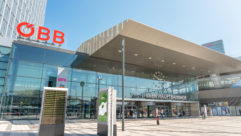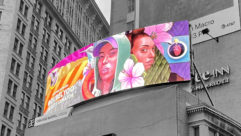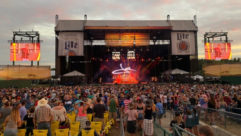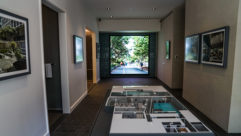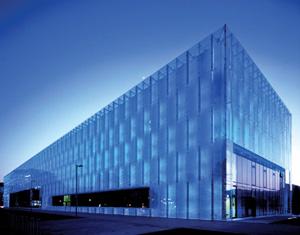

Urban Screens
Screen media technology is becoming an element of urban architecture through the combination of transparent building materials, digital light, and transmission technology. Architecture and media technology is melting into each other, and buildings are becoming media infrastructure. As with all ?new? technologies, this convergence of buildings and media technology has been envisaged for some time; what is new is not the idea, but the ways in which current material technology makes it possible.
SCREEN MEDIA TECHNOLOGY IS BECOMING AN ELEMENT OF urban architecture through the combination of transparent building materials, digital light, and transmission technology. Architecture and media technology is melting into each other, and buildings are becoming media infrastructure. As with all “new” technologies, this convergence of buildings and media technology has been envisaged for some time; what is new is not the idea, but the ways in which current material technology makes it possible.
The Lentos Museum of Modern Art in Linz, Austria uses translucent screen technology to transform its exterior architecture at night.
We’re at that tipping point where technology and material conditions for production enable the diffusion and use of new media technologies. The use of digital screen technology in transparent or fluorescent building materials for projection of digital images on building façades is changing the meaning of both media and architecture.
We are becoming able to replace and change the ensemble landscape of urban buildings with active and dynamic media technology that can radically modify a city. Buildings, urban landscapes, and sites are disintegrating to become autonomous, informational, and transitional objects. Thus to interpret this emerging electronic urban landscape, both as a cultural and socio-spatial landscape, is of great importance.
Interestingly, some of the best examples of this use of materials and media technologies are media company buildings. In Copenhagen, Denmark, the new building for the national public broadcasting institution, Danmarks Radio (DR), is a high profile, urban architecture project that is using digital screen technology in advanced and new ways.
NEW MEDIA IN THE URBAN LANDSCAPE
Part of the construction project for Danmarks Radio is a new concert hall that uses screen technology to help fulfill the goal of creating a focal point for creativity and innovation. The French architects Atelier Jean Nouvel won the competition for the concert hall in 2002, and the building is scheduled to be finished this year.
According to the architect’s vision, the concert hall “will be a volume, a mysterious parallelepiped that changes under the light of day and night whose interior can only be guessed at. At night the volume will come alive with images, colors, and lights expressing the life going on inside.”
The new broadcasting company buildings are no longer built to function mostly as effective television production plants; they are also meant to become avant-garde signature buildings in urban settings. They are, in a sense, physically becoming what they are known to produce — a visual impact, able now to imagine themselves not only as contributing to the old, two-dimensional visual culture, but entering the role of urban monuments.
INTERPRETING ELECTRONIC LANDSCAPES
Screen technology is representing a new way of thinking about building façades and decorative elements in building structures. The new technology can be combined with various materials, particular glass and plastics, that give architects and urban planners the possibility of thinking about buildings as more transitory and mobile objects with transformational, decorative, and informative possibilities.
Instead of the gray concrete or the darkened windows that tortured urban architecture in ’80s, new urban architecture is transparent and translucent, fluorescent and colorful. And it can change itself, being transparent at one moment, translucent in the second, and carrying moving pictures in the third.
At the Lentos Museum of Modern Art in Linz, Austria, architecture and audiovisual media has the potential to interrogate the borders between the urban and the suburban, and between the urban landscape and the natural environment.
In some ways, screen technology is landscape that can be seen from the way the technology actually includes reflection and camouflage strategies, making it possible to simulate a seamless integration between screen and environment. Screen media technology can (more or less) in one moment be made to disappear; and in the next moment, stand out, seek connections, and ask for your involvement and interactivity.
The screen thus does not resemble earlier media technologies that had to have a separate physical carrier (the radio, the telephone, the television set). Instead, it can disappear, become a wall, become a window, hide as modern architecture, or fake another building’s façade.
If the fireplace can be used as a prehistoric metaphor for domestic media culture, then the sky — where stars appear at night, but where a cloud can cause everything to disappear — is the metaphor for the urban screen. Read as a sign of civilization, screen media buildings achieve some meaning as a new lighthouse of a new modernity: but not as in Edward Hopper’s image of the lighthouse on the cliff, securing the navigation of ships. Today, the beacon is in the center, as a landmark of a total commercial culture.
As Paul Virilo, French cultural theorist, writes, “… The pixel replaces the bolt and rivet. The eye of the telespectator slides along the length of an infinite electronic perspective, and the architecture of light becomes nothing more than the computer’s memory.”
A wide range of new possibilities for visual art and cultural reflection has arrived. From a critical media perspective, it is necessary to look into the urban screen technology also as a means for developing alternative media. The question is how one might influence the development of screen media technology so that interactive, popular, and participatory. Political use of urban screen media is not politically prohibited nor economically restricted to commercial culture.
Increasingly, it is access to technology itself that designates the insides and the outsides of society. It is the ability to interact with technology rather than the physical experience of urban landscape, nature and buildings that gives meaning to space.
Tore Slaatta, professor in the Department of Media and Communication at the University of Oslo, Norway, writes on issues related to urban development, design, architecture, and art criticism. He can be reached at [email protected].


